While billionaires buy tigers and cheetahs to impress mere mortals around the world, we prefer German shepherds and what they represent. Although speed is not the first thing that comes to mind with GSDs, it is fun thinking what is the fastest a German shepherd can run.
Being herding dogs, they do have it in their genetics to run relatively fast, but how fast is that? It is faster than their owner, that is for sure. Despite not being among the fastest dog breeds, the German shepherd dog is a perfect mixture of strength and speed.
Along with their high intelligence, they are one of the most loved and appreciated breeds on the planet, so no wonder you want to know all about them. Accompany me while we figure out what is the fastest a German shepherd can run and how they accomplish their top speed.
German Shepherd Run Fast, And The Magic Number Is…
Achieving high running speeds requires specific physical features, and the German shepherd dog has many of them. From the get-go, you can tell they will not be the fastest dog breed around due to them being a medium-large-sized dog breed, but you will still be dazzled by the revelation.
What is the fastest a German shepherd can run? The consensus is that the German shepherd’s speed while running tops out a just under thirty miles per hour.
That is pretty fricking fast, so clearly, they are no slouches when it comes to running fast. A working dog has to be quick and agile, but herding is not for slowpokes either.
Obviously, high-speed chasing presents no challenge for the GSD, but you should be aware that they cannot sustain that speed for longer periods of time. To be honest, no creature on earth can run indefinitely at its top speed.
Different Type Of German Shepherd Dog, Different Top Speed?
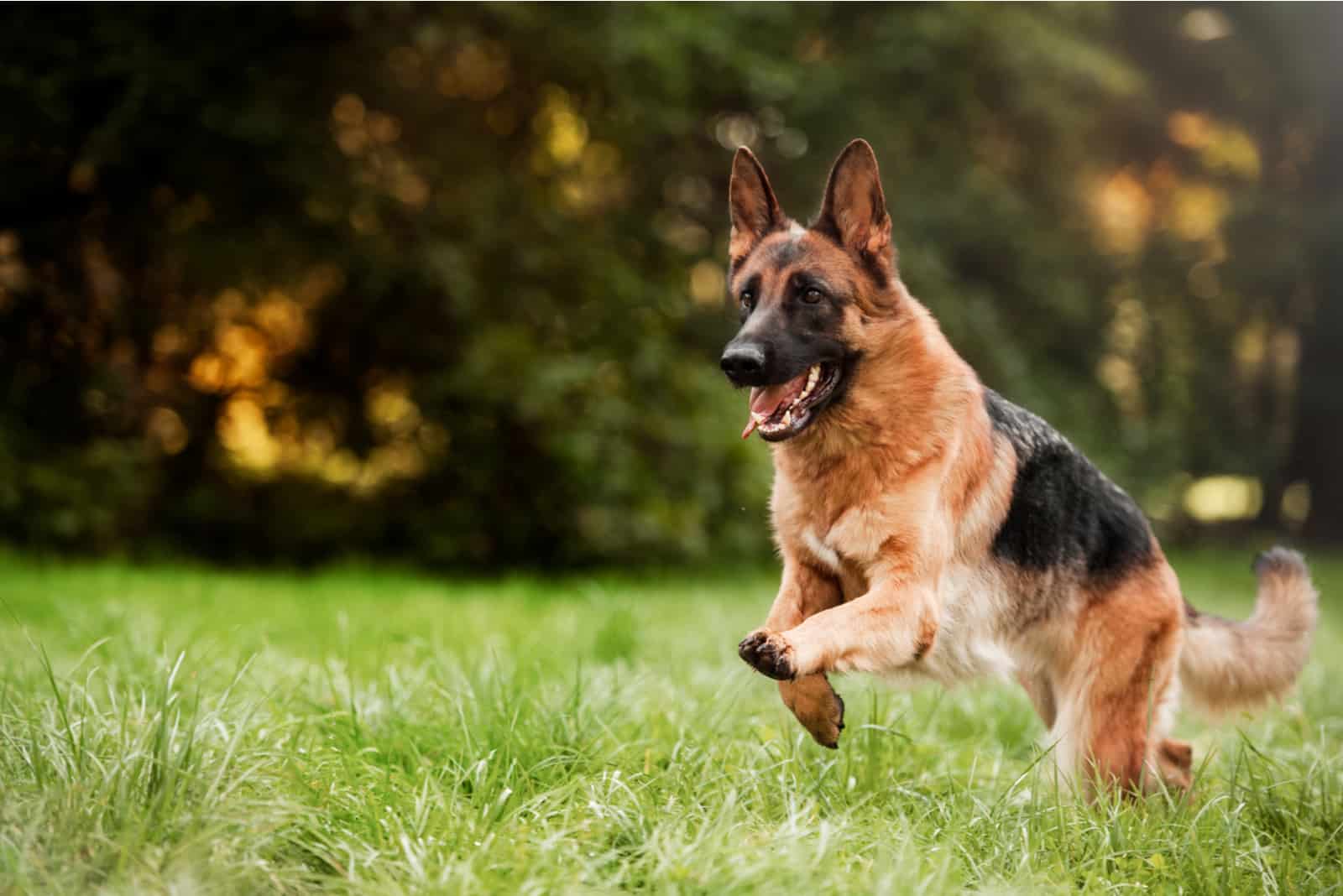
Considering there are two main types of GSD with apparent anatomical differences, their full-speed run can be affected considering their physical build.
The first is the working line German shepherd dog. They have a squarish silhouette, flat backs, and more muscle mass. In addition, their skull shape is less aerodynamic compared to the show line GSD, which also means thicker bones throughout the body.
The show line German shepherd dog has a slightly slanted back, thinner bones, is smaller in stature and has a more athletic body shape. Naturally, the working line dog is more robust due to its role.
Having the strength to perform whichever task the working line German shepherd is given means sacrificing some of the agility and speed, so expect to see the number closer to twenty-five miles per hour.
A show line GSD is going to be quicker due to a physique that cuts through the air more easily, less weight, and a more athletic than stocky body frame. The speed of a show line GSD is the already established thirty miles per hour.
All The Things That Help A German Shepherd Achieve A High-Speed Run
Regardless of type, the German shepherd’s anatomy helps it quite a bit in reaching these kinds of running speeds. According to the AKC breed standards, male GSDs reach a height of twenty-four to twenty-six inches and weigh between sixty-five and ninety pounds.
Females grow as tall as twenty-two to twenty-four inches and can weigh around fifty to seventy pounds. It is likely that a male GSD will be faster due to more muscle mass, but the difference is negligible.
If you are finding it hard to decide whether to get a male or female GSD, check our Male vs female German shepherd article. What is the fastest a German shepherd can run? Thirty miles per hour. How? The following five elements make it possible.
1. The Muzzle
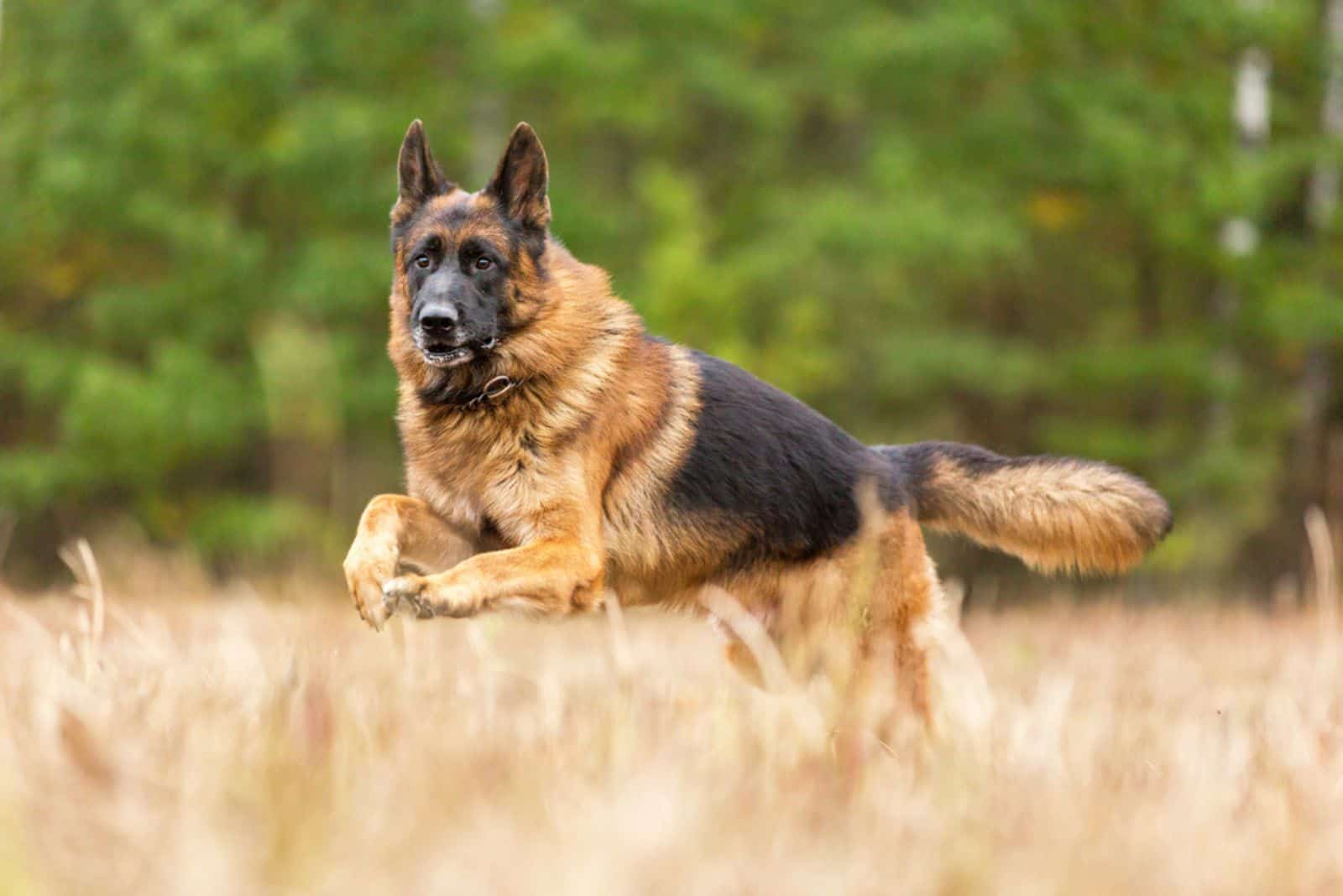
You might consider the muzzle irrelevant in the grand scheme of things, but a square-shaped skull and short muzzle like in a Great Dane will significantly slow down the dog.
German shepherd dogs have a long muzzle with a moderate stop that is proportional to the width of the skull. The way the muzzle breaks the air before a dog as it runs affects the run speed in a major way.
With every lunge forward, the muzzle helps make an opening in the mass of air right in front of the dog. The pointed muzzle is far superior to a large square surface in doing that, so a German shepherd is faster than let us say a Labrador Retriever.
Keep in mind that German shepherd puppies will have a more rounded or square-shaped body because they are still developing into grown adults. At around eighteen months, your GSD will have achieved physical maturity. Check our German shepherd growth chart for more details.
2. The Neck
Controlling the aerodynamically shaped head of the German shepherd dog, the long, muscular neck is held high, though it is closer to being extended forward than upward.
This forward position allows the dog’s body to form an arrow shape with the neck holding the pointed muzzle straight and balanced. The strong muscles of the neck help with making abrupt turns without losing much speed, too.
If anything, the neck is particularly useful at getting the engine started, but what is the fastest a German shepherd can run is a question for the legs. Let us see what goes on there.
3. The Legs
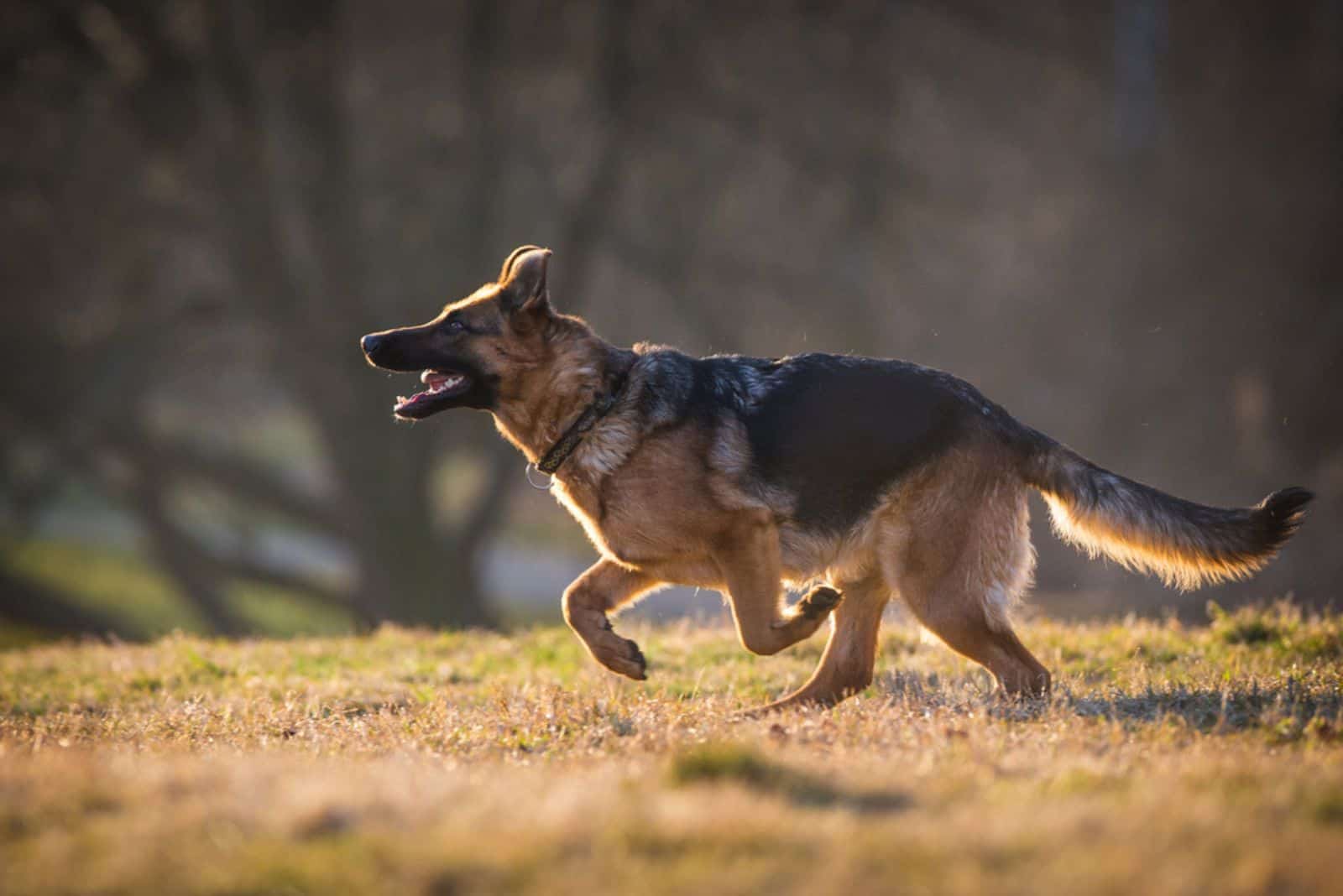
Although the GSD’s legs are nothing out of this world, it is interesting how the front leg pasterns are set at a twenty-degree angle, allowing the dog to tuck in its legs when running at full speed.
Needless to say, this creates less friction while in the air and provides a smaller surface area for the air to hit. The hind legs are flexible and become almost parallel with the ground while running at full speed.
Another bonus is the pretty lightweight structure of the leg bones, aided by compact feet that do not impact movement. Last but not least, the hind legs of a German shepherd dog generate a lot of power. This allows them to thrust forward and cover long distances with one stride.
That giant stride is called a double-suspension gallop and it is the last “gear” dogs have when running. All breeds achieve top speeds during double-suspension gallops, so it is not exclusive to the GSD, but it does work great for its body frame.
During a DSG, the dog is in full extension, which means the front and hind legs are both fully stretched in their respective directions. To achieve a double-suspension gallop, a dog’s back has to have a very fast arch-to-straight-back transition.
4. The Back And Tail
Many of us would not consider the back to have a big impact in managing a high-speed run, but it really does. A German shepherd has a well-muscled straight back (slightly slanted in the show line) that keeps the body rigid and straight during running.
Keeping the form while “flying” through the air makes them look effortless both while trotting and at full speed. For this reason, they are among the most favored police dogs in the world, second only to the Belgian Malinois.
The long tail, although covered in a dense coat, acts as a rudder. It helps the dog turn tight corners, keep balance, and even adds some speed control, similar to a spoiler on a car. Being the extension of a flexible spine, the tail is more important owners would assume.
German Shepherds’ Legs Are Prone To Health Problems
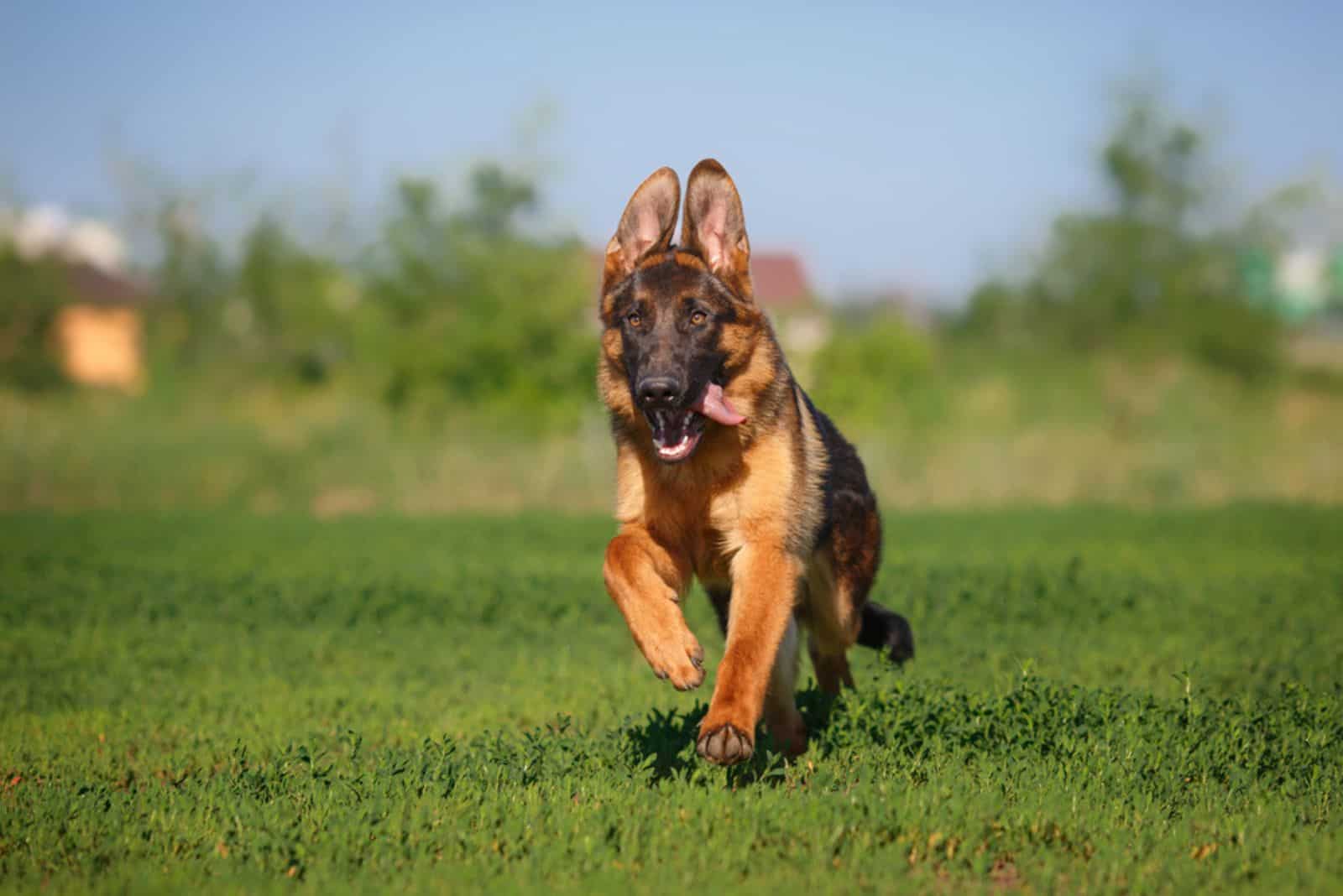
As I always say, breeder choice is the first and most important thing to figure out before going out to buy a German shepherd. The GSD has been replaced by Belgian shepherds due to their superior work drive and athleticism without compromising on intelligence.
Due to inbreeding, hip dysplasia has been running rampant across the German shepherd dog, so they are somewhat of a mascot for this condition. They are also prone to degenerative myelopathy, which affects the hind legs, so the health bill is not quite clean.
Hip Dysplasia
Although elbow dysplasia is also present among dogs, it is not as common as hip dysplasia. Being a congenital condition (inherited at birth), it is a genetic mutation that causes the fit between the ball and socket of the hip joint to be faulty.
A German shepherd puppy’s femoral bone will not fully develop, so the cartilage that functions as cushion and lubrication between the hip bone and femur head begins to wear off as the dog runs and moves around.
Once the cartilage is completely gone, two bones grind against each other, causing tissue damage. The tissue will become inflamed and ultimately lead to arthritis. While there is no cure for dysplasia, symptoms can be managed with NSAIDs and other drugs.
However, surgical options exist that include juvenile pubic symphysiodesis, triple pelvic osteotomy, femoral head osteotomy, and total hip replacement. The first procedure is only viable in dogs aged under five months.
Osteotomies are essentially procedures performed on the femur head itself that involve using a saw and artificial plates to improve the way the joint functions.
Degenerative Myelopathy (DM)
This condition is also inherited from the puppy’s parents, but the symptoms do not start until the German shepherd reaches at least the age of eight or nine.
Unfortunately, it is a progressive disease, meaning its effects cannot be reversed. Your dog will get worse as the condition keeps developing. Initially, the spinal cord is affected in a way that causes loss of muscle and coordination in the back legs.
After six to twelve months of symptom onset, the most likely scenario is your dog being unable to walk. With the progression of degenerative myelopathy, the front legs become affected as well.
German shepherd dogs are a higher risk group than many other dog breeds, simply because of the previously mentioned inbreeding, but Boxers, Rhodesian Ridgebacks, and some other breeds are prone to it, too.
The main symptoms include loss of muscle mass, lack of coordination, back legs weakness, not being able to get up, and toenail injury. While there is no way to cure DM, physical therapy can slow down the progression of the disease.
If German Shepherds Are Not The Fastest, Which Breed Is?
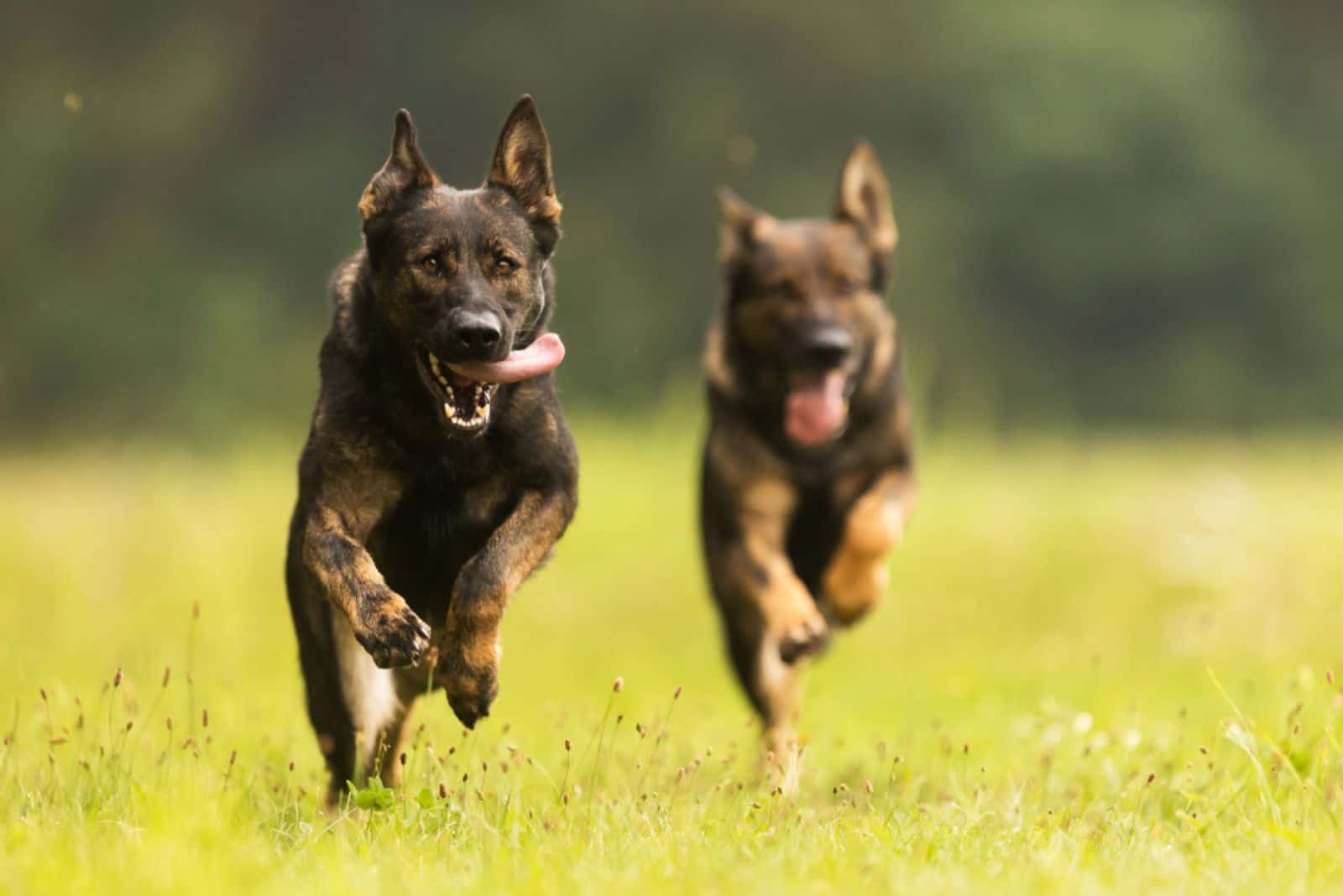
With a proven track record of being exemplary service dogs, guard dogs, and perfect family pets, the German shepherd dogs have much to offer. Breaking speed records, however, is not their forte.
Still, they are a sweet spot between strength and speed, unlike a Rottweiler, which specializes in power, but cannot run faster than twenty-five miles per hour and has relatively low stamina. They are considered superior protection dogs than GSDs, so learn about how aggressive they really are.
Thirty miles per hour is still impressive considering GSDs do not have particularly long legs, but their legs do remain close to the ground while running. Their high energy levels are also useful for running longer at slightly lower speeds.
Here is a speed chart I made to showcase the fastest dog breeds in the world with Usain Bolt as a reference point when it comes to the fastest human being on Earth. Many of these breeds are also hunting dogs, so a gazelle and cheetah will be added as a bonus.
| Contender | Group | Size | Top Speed |
|---|---|---|---|
| Cheetah | Big Cats | Large | 76 mph |
| Greyhound | Sighthound | Medium | 45 mph |
| Gazelle | Antelope | Large | 43 mph |
| Saluki | Sighthound | Medium | 42 mph |
| Whippet | Sighthound | Medium | 35 mph |
| Doberman | Working | Medium-Large | 32 mph |
| Border Collie | Herding | Medium | 30 mph |
| Poodle (standard | Non-Sporting | Medium-Large | 30 mph |
| Siberian Husky | Working | Medium | 30 mph |
| Jack Russell Terrier | Terrier | Small | 30 mph |
| Chihuahua | Toy Dog | Small | 30 mph |
| Usain Bolt | Human | Large | 28 mph |
Breakdown Of The Speed Chart

As you can see, the sizing was determined in comparison with dogs, so Usain Bolt, cheetahs, and gazelles are all large in comparison with the dogs on this chart.
Even the best athlete in the world when it comes to sprinting cannot match a Chihuahua. It is expected though, is it not? We only have two legs and zero aerodynamics compared to predatorial animals.
You will also notice there are no large dogs on the fastest breed chart. That is for good reason. Most large breeds like Malamutes, Great Danes, Mastiffs, etc., are too muscular and have a less athletic predisposition for reaching high speeds.
Have a look at this comparison of Malamute and Husky traits to see which one wins in your book. Do not be too harsh on them, they are sensitive and vocal.
However, sighthounds have a trick up their sleeve. Their slim profile and long, muscular legs, provide enormous power during the double-suspension gallop.
This compound movement is very taxing on the body, so both sighthounds and cheetahs can attain high speeds for short bursts of time. A gazelle, on the other hand, can spend quite a while running at forty-five miles per hour.
The Saluki breed is almost as fast as Greyhounds but has vastly better stamina than it. It is likely that its genetics hold the answer to the why seeing how they were used for hours-long hunting sessions.
A Doberman seems to be great competition for the German shepherd dog, and with a similar list of features, you might find it tough to choose between the two. Here is a comprehensive read dealing with the dilemma of a Doberman vs a German shepherd.
Final Word
Well, the German shepherd is obviously an averagely quick dog, so to answer “What is the fastest a German shepherd can run?” you could say they are as fast as dog breeds with similar features.
The speed chart shows that many dogs, regardless of size match the German shepherd’s top speed. Still, they all have different traits, meaning your GSD is still a special canine.
If you like your dog to run fast or need a great farm assistant, then the German shepherd dog is great, but the Collie and Australian Kelpie are better. If you want a working dog or guard dog, they are excellent, but the Rottweiler or Doberman might be better.
So, the GSD’s speed puts it in the all-rounder dog category, which leads to one conclusion — they are among the best family pets in the world due to a balance of physical and mental traits.















